SEO
Where We Are Today With Google’s Mobile-First Index

Okay, so it’s been a few years now since Google announced the mobile-first index.
Most sites have been moved over to Google’s mobile-first index and it’s no longer a “hot” topic in SEO.
I found a tweet from John Mueller, Google Search Advocate, in 2021 that sums up the lack of focus on this topic the best:
My guess is mobile-first indexing has been ongoing for so many years now that it’s more like a “part of life” :). @maxxeight also has a neat tool for testing at https://t.co/r9gFpp95uO . Most sites are moved over, so I don’t expect giant fluctuations.
— 🐐 John 🐐 (@JohnMu) March 12, 2021
Going with that mentality that mobile-first indexing is a “part of life” (which I wholeheartedly agree with), as an SEO, it is helpful to know some of the history and where we are today.
For instance, since the announcement of the mobile-first index years ago, Google has now also placed emphasis on Page Experience, which is a ranking factor and very much incorporates mobile.
Before we jump into that topic, let’s first get into the beginnings of the mobile-first index and what we know so far.
Then, we’ll get into what Google is looking for in mobile usability, what it means to have an identical experience on mobile and desktop, how you can meet Google’s expectations of mobile-first best practices, and more.
Google’s Mobile-First Indexing
No, There Are Not Two Indexes
Google has stated that there isn’t a separate mobile-first index.
Instead, mobile-first indexing means Google primarily uses the mobile version of the webpage for ranking and indexing purposes.
In 2018, Google explained that with mobile-first indexing, the URL of the mobile-friendly version of your site is indexed.
If your website has separate mobile and desktop URLs, Google shows the mobile URL to mobile users and the desktop URL to desktop users.
Regardless, the indexed content will be the mobile version.
Shifting To The Mobile-First Index
At the end of 2017, Google announced that it would start slowly rolling out mobile-first indexing.
By March 2018, Google stated that they were expanding the rollout and instructed websites to prepare.
Fast forward three years later and not all websites have been switched over to the mobile index.
In June 2020, Google stated that while most websites were set to mobile indexing, there were still many that were not.
Google announced at that point that instead of switching in September 2020, it would delay mobile-first indexing until March 2021.
Google cited a number of issues encountered with sites as a reason for delaying the rollout, including problems with robots meta tags, lazy-loading, blocked assets, primary content, and mobile images and videos.
Eventually, Google removed its own self-imposed deadline in November 2021 explaining that there were still sites that were not yet in the mobile-first index because they weren’t ready to be moved over.
Google went on to say that the lack of readiness was due to several unexpected challenges faced by these websites.
According to Google, “because of these difficulties, we’ve decided to leave the timeline open for the last steps of mobile-first indexing.”
Google also stated that “we currently don’t have a specific final date for the move to mobile-first indexing and want to be thoughtful about the remaining bigger steps in that direction.”
Mobile-First Indexing As The Default For New Websites
If your website was published after July 1, 2019, mobile-first indexing is enabled by default.
Google made this announcement in May 2019 and explained that the change applied to websites that were previously unknown to Google Search.
The announcement went into detail about why Google would make mobile-first indexing the default for new websites.
According to Google, after crawling the web with a smartphone Googlebot over the years, they concluded that new websites are typically ready for this type of crawling.
Mobile Usability And Mobile-First Indexing Are Not Synonyms
In January 2019, Mueller explained that if your content does not pass the mobile usability test, it could still be moved to mobile-first indexing.
Even if Search Console’s “mobile usability” report showed that your site had valid URLs, it didn’t mean those pages were ready for mobile-first indexing.
Mobile usability is “completely separate” from mobile-first indexing, according to Mueller. Consequently, pages could be enabled for mobile-first indexing even if they were not considered usable on a mobile device.
You can hear Mueller’s explanation in the video below, starting at the 41:12 mark:
“So, first off, again mobile usability is completely separate from mobile-first indexing.
A site can or cannot be usable from a mobile point of view, but it can still contain all of the content that we need for mobile-first indexing.
An extreme example, if you take something like a PDF file, then on mobile that would be terrible to navigate. The links will be hard to click, the text will be hard to read.
But all of the text is still there, and we could perfectly index that with mobile-first indexing.
Mobile usability is not the same as mobile-first indexing.”
In summary, mobile-friendliness and mobile-responsive layouts are not mandatory for mobile-first indexing.
Since pages without mobile versions still work on a mobile device, they were eligible for indexing.
The Mobile & Desktop Experiences Should Be The Same
Google added to their mobile-first indexing best practices in January 2020, and the big emphasis was on providing an identical experience on mobile and desktop.
Matt Southern provided a great summarized list of what Google meant by the same experience:
- Ensuring Googlebot can access and render mobile and desktop page content and resources.
- Making sure the mobile site contains the same content as the desktop site.
- Using the same meta robots tags on the mobile and desktop site.
- Using the same headings on the mobile site and desktop site.
- Making sure the mobile and desktop sites have the same structured data.
Google warns that if you purposefully serve less content on the mobile version of a page than the desktop version, you will likely experience a drop in traffic.
The reason? According to Google, they won’t be able to get as much information from the page as before (when the desktop version was used).
Instead, Google recommends that the primary content on the mobile site be the same as on the desktop site. Google even suggests using the same headings on the mobile version.
To drive this point home, even more, Google mentions in its mobile-indexing documentation that only the content on the mobile site is used in indexing.
Therefore, you should be sure that your mobile site has the same content as your desktop site.
Mueller reiterated this fact during Pubcon Pro Virtual 2020 with the following comment:
“…we’re now almost completely indexing the web using a smart phone Googlebot, which matches a lot more what users would actually see when they search.
And one of the things that we noticed that people are still often confused about is with regards to, like if I only have something on desktop, surely Google will still see that and it will also take into account the mobile content.
But actually, it is the case that we will only index the mobile content in the future.
So when a site is shifted over to mobile first indexing, we will drop everything that’s only on the desktop site. We will essentially ignore that.
…anything that you want to have indexed, it needs to be on the mobile site.”
You can read more about Mueller’s comments here: Google Mobile-First Index – Zero Desktop Content March 2021.
Google’s Mobile-First Indexing Best Practices
Google provides a comprehensive list of best practices for mobile-first indexing “to make sure that your users have the best experience.”
Most of the information Google shares as best practices is not really new.
Instead, the list is a compilation of various recommendations and advice that Google has provided elsewhere over the years.
In addition to the list of recommendations above about creating the same experience on mobile and desktop, other best practices include:
- Making sure the error page status is the same on the mobile and desktop sites.
- Avoiding fragment URLs in the mobile site.
- Making sure the desktop pages have equivalent mobile pages.
- Verifying both the mobile and desktop sites in Search Console.
- Checking hreflang links on separate mobile URLs.
- Making sure the mobile site can handle an increased crawl rate.
- Making sure the robot.txt directives are the same on the mobile and desktop sites.
Google offers an entire section focused on suggestions for separate URLs.
The “Troubleshooting” section of the best practices document is also worth checking out.
It includes common errors that can either cause your site to not be ready for mobile-first indexing or could lead to a drop in rankings once your site is enabled.
Note that Mueller explained nothing has changed with mobile-first indexing related to sites with separate mobile URLs using rel-canonical. Mueller recommends keeping the annotations the same.
Google will use the mobile URL as canonical even if the rel-canonical points to the desktop URL.
Mueller created a helpful graphic that shows a “before and after” indexing process for desktop and m-dot URLs.
Read more: Google’s John Mueller Clears Confusion About Mobile-First Index.
I occasionally get questions about this, so just to be clear: if you have separate mobile URLs (with rel-alternate / rel-canonical links), with mobile first indexing you *don’t* need to change anything. Keep the same annotations. No changes needed. pic.twitter.com/nGPucxPXWn
— 🐝 johnmu.csv (personal) 🐝 (@JohnMu) January 18, 2021
One last note about best practices.
In Google’s mobile-first indexing best practices documentation, it states, “While it’s not required to have a mobile version of your pages to have your content included in Google’s search results, it is very strongly recommended.”
While it might seem obvious to have a mobile version, I have gotten pushback when speaking about mobile-first.
At one conference, an attendee asked during my session if having a mobile version of the site was necessary if no one was coming from a mobile device.
He kept emphasizing “no one.” My answer? Do it anyway.
Not only does Google very highly recommend it, but visitors, especially repeat visitors, might not be using mobile devices because of the poor experience.
We need to focus not just on getting pages ranked in search results, but also on ensuring that the visitor has a good experience once on the page.
Page Experience Update + Mobile-First
The Page Experience update also needs to be part of the conversation.
The Page Experience update was officially released for mobile devices in 2021 and includes measurement signals regarding how visitors perceive their experience of interacting with your web page.
According to Google, this perception goes beyond just the information value provided on the page. Therefore, Google takes into account loading performance, visual stability, and interactivity of the page, which is known as Core Web Vitals.
Page Experience also looks at mobile-friendliness, HTTPS, and intrusive interstitials, which were already a part of the ranking algorithm.
For instance, mobile-friendliness was announced as a ranking factor in 2015, which led to Mobilegeddon (the industry’s name for the update… not Google’s name).
This factor took into account text readability, spacing of tap targets, and unplayable content.
A year later, Google announced that it was strengthening this ranking factor.
Originally, the mobile-friendly update was meant to apply to mobile search results only, but now with the mobile-first index, it applies overall.
Let’s get back to Core Web Vitals.
Core Web Vitals are factors Google considers important in a user’s overall experience on the webpage, including Largest Contentful Paint (LCP), First Input Delay (FID), and Cumulative Layout Shift (CLS).
Each of these factors contributes to the user experience and is scored as “Good,” “Needs Improvement,” or “Poor.”
Now, let’s see how this relates to mobile-first indexing.
There is a lot of overlap between Core Web Vitals and the mobile-first index because both look at how a page performs on a mobile device.
To tie this together, you can reference one of the mobile-first indexing best practices provided by Google, which is to ensure your mobile site loads fast.
Google offers specific recommendations, including using Google PageSpeed Insights and focusing on the “Speed” section. Note that there are other tools you can use too to test speed, such as GTMetrix and WebPageTest.
Martin Splitt, who works in Google’s Developer Relations, was asked in May 2021 if the Page Experience Update was going to roll out on mobile and desktop pages at the same time.
His response was that it would start with mobile pages first, which it did in August 2021. It would be rolled out on desktop pages in February 2022.
It was also made clear that Google would assess mobile pages separately from desktop pages, meaning there is no aggregate score of mobile and desktop (at least not for now).
You can access both the desktop and mobile Page Experience reports in Google Search Console.
Just as you need to pay attention to the desktop and mobile versions of your site for the mobile-first index, you also need to for the Page Experience update.
Check out Core Web Vitals: A Complete Guide for detailed information about this update and how to implement fixes.
One last note before we move on: When Google scores a page, it will test the speed, stability, and usability of the page version that the user ends up seeing.
Here’s where things get tricky. For Core Web Vitals, if you have an AMP version, Google will use it for page experience scoring (i.e., speed, quality, and usability). The mobile version would not be used.
Yet, the mobile version is what would be crawled for the mobile-first index.
So, to sum it up, the AMP version would be used for Core Web Vitals scoring and the mobile version would be used for mobile-first indexing.
Read Google Mobile-First Indexing and Scoring of Sites with Mobile and AMP Versions for the full explanation from Mueller.
Improve Performance In Google’s Mobile-First Index
Here is a consolidated list of items to check that build on some of the best practices already provided.
1. If You Have Multiple Versions, Make Sure Important Content Is Shown On All
Make sure your important content – including structured data, internal links, images, and so on – is on the mobile version of your website, too.
Google even warns in its mobile-indexing best practices that if you have less content on your mobile page than the desktop page, you will experience some traffic loss when your site is moved to mobile-first indexing,
Read more here: Google: Mobile-Friendly Does Not Mean Ready For Mobile-First Index.
2. Let Googlebot Access And Render Your Content
Google recommends that you use the same meta robots tags on the mobile site, avoid lazy-loading primary content (Googlebot can’t load content that requires user interaction), and allow Googlebot to crawl your resources.
3. Verify Structured Data
Double-check that your structured data is the same on both the desktop and mobile versions of your website and also ensure the URLs are correct.
4. Improve Mobile Page Speed
Page speed has been a factor to consider for a long time and it is even more important with the mobile-first index and Page Experience update.
Advanced Core Web Vitals: A Technical SEO Guide is packed with how-to advice on identifying and addressing speed-related factors that impact Core Web Vitals and mobile-first indexing.
5. Keep An Eye On Mobile Errors
As with most SEO work, getting a site to perform well in the mobile-first index is not a “one and done” task. You need to be closely monitoring Search Console so that you can identify and fix mobile errors.
Make it a habit to regularly view the “mobile usability” and “Core Web Vitals” reports in Search Console.
Keep Reading: Google’s Changelog On Mobile-First Indexing
The changelog in Google’s mobile-first indexing best practices gives a quick recap of the changes since 2016.
As you can tell, there is a lot to know and keep in mind on mobile-first indexing.
Make sure you are staying on top of best practices and monitoring your website’s performance to succeed in the world of mobile-first indexing.
More Resources:
Featured Image: DisobeyArt/Shutterstock
SEO
Google Confirms Links Are Not That Important

Google’s Gary Illyes confirmed at a recent search marketing conference that Google needs very few links, adding to the growing body of evidence that publishers need to focus on other factors. Gary tweeted confirmation that he indeed say those words.
Background Of Links For Ranking
Links were discovered in the late 1990’s to be a good signal for search engines to use for validating how authoritative a website is and then Google discovered soon after that anchor text could be used to provide semantic signals about what a webpage was about.
One of the most important research papers was Authoritative Sources in a Hyperlinked Environment by Jon M. Kleinberg, published around 1998 (link to research paper at the end of the article). The main discovery of this research paper is that there is too many web pages and there was no objective way to filter search results for quality in order to rank web pages for a subjective idea of relevance.
The author of the research paper discovered that links could be used as an objective filter for authoritativeness.
Kleinberg wrote:
“To provide effective search methods under these conditions, one needs a way to filter, from among a huge collection of relevant pages, a small set of the most “authoritative” or ‘definitive’ ones.”
This is the most influential research paper on links because it kick-started more research on ways to use links beyond as an authority metric but as a subjective metric for relevance.
Objective is something factual. Subjective is something that’s closer to an opinion. The founders of Google discovered how to use the subjective opinions of the Internet as a relevance metric for what to rank in the search results.
What Larry Page and Sergey Brin discovered and shared in their research paper (The Anatomy of a Large-Scale Hypertextual Web Search Engine – link at end of this article) was that it was possible to harness the power of anchor text to determine the subjective opinion of relevance from actual humans. It was essentially crowdsourcing the opinions of millions of website expressed through the link structure between each webpage.
What Did Gary Illyes Say About Links In 2024?
At a recent search conference in Bulgaria, Google’s Gary Illyes made a comment about how Google doesn’t really need that many links and how Google has made links less important.
Patrick Stox tweeted about what he heard at the search conference:
” ‘We need very few links to rank pages… Over the years we’ve made links less important.’ @methode #serpconf2024″
Google’s Gary Illyes tweeted a confirmation of that statement:
“I shouldn’t have said that… I definitely shouldn’t have said that”
Why Links Matter Less
The initial state of anchor text when Google first used links for ranking purposes was absolutely non-spammy, which is why it was so useful. Hyperlinks were primarily used as a way to send traffic from one website to another website.
But by 2004 or 2005 Google was using statistical analysis to detect manipulated links, then around 2004 “powered-by” links in website footers stopped passing anchor text value, and by 2006 links close to the words “advertising” stopped passing link value, links from directories stopped passing ranking value and by 2012 Google deployed a massive link algorithm called Penguin that destroyed the rankings of likely millions of websites, many of which were using guest posting.
The link signal eventually became so bad that Google decided in 2019 to selectively use nofollow links for ranking purposes. Google’s Gary Illyes confirmed that the change to nofollow was made because of the link signal.
Google Explicitly Confirms That Links Matter Less
In 2023 Google’s Gary Illyes shared at a PubCon Austin that links were not even in the top 3 of ranking factors. Then in March 2024, coinciding with the March 2024 Core Algorithm Update, Google updated their spam policies documentation to downplay the importance of links for ranking purposes.
The documentation previously said:
“Google uses links as an important factor in determining the relevancy of web pages.”
The update to the documentation that mentioned links was updated to remove the word important.
Links are not just listed as just another factor:
“Google uses links as a factor in determining the relevancy of web pages.”
At the beginning of April Google’s John Mueller advised that there are more useful SEO activities to engage on than links.
Mueller explained:
“There are more important things for websites nowadays, and over-focusing on links will often result in you wasting your time doing things that don’t make your website better overall”
Finally, Gary Illyes explicitly said that Google needs very few links to rank webpages and confirmed it.
I shouldn’t have said that… I definitely shouldn’t have said that
— Gary 鯨理/경리 Illyes (so official, trust me) (@methode) April 19, 2024
Why Google Doesn’t Need Links
The reason why Google doesn’t need many links is likely because of the extent of AI and natural language undertanding that Google uses in their algorithms. Google must be highly confident in its algorithm to be able to explicitly say that they don’t need it.
Way back when Google implemented the nofollow into the algorithm there were many link builders who sold comment spam links who continued to lie that comment spam still worked. As someone who started link building at the very beginning of modern SEO (I was the moderator of the link building forum at the #1 SEO forum of that time), I can say with confidence that links have stopped playing much of a role in rankings beginning several years ago, which is why I stopped about five or six years ago.
Read the research papers
Authoritative Sources in a Hyperlinked Environment – Jon M. Kleinberg (PDF)
The Anatomy of a Large-Scale Hypertextual Web Search Engine
Featured Image by Shutterstock/RYO Alexandre
SEO
How to Become an SEO Lead (10 Tips That Advanced My Career)

A few years ago, I was an SEO Lead managing enterprise clients’ SEO campaigns. It’s a senior role and takes a lot of work to get there. So how can you do it, too?
In this article, I’ll share ten tips to help you climb the next rung in the SEO career ladder.
Helping new hires in the SEO team is important if you want to become an SEO Lead. It gives you the experience to develop your leadership skills, and you can also share your knowledge and help others learn and grow.
It demonstrates you can explain things well, provide helpful feedback, and improve the team’s standard of work. It shows you care about the team’s success, which is essential for leaders. Bosses look for someone who can do their work well and help everyone improve.
Here are some practical examples of things I did early in my career to help mentor junior members of the team that you can try as well:
- Hold “lunch and learn” sessions on topics related to SEO and share case studies of work you have done
- Create process documents for the junior members of the team to show them how to complete specific tasks related to your work
- Compile lists of your favorite tools and resources for junior members of the team
- Create onboarding documents for interns joining the company
Wouldn’t it be great if you could look at every single SEO Lead’s resume? Well, you already can. You can infer ~70% of any SEO’s resume by spying on their LinkedIn and social media channels.
Type “SEO Lead” into LinkedIn and see what you get.
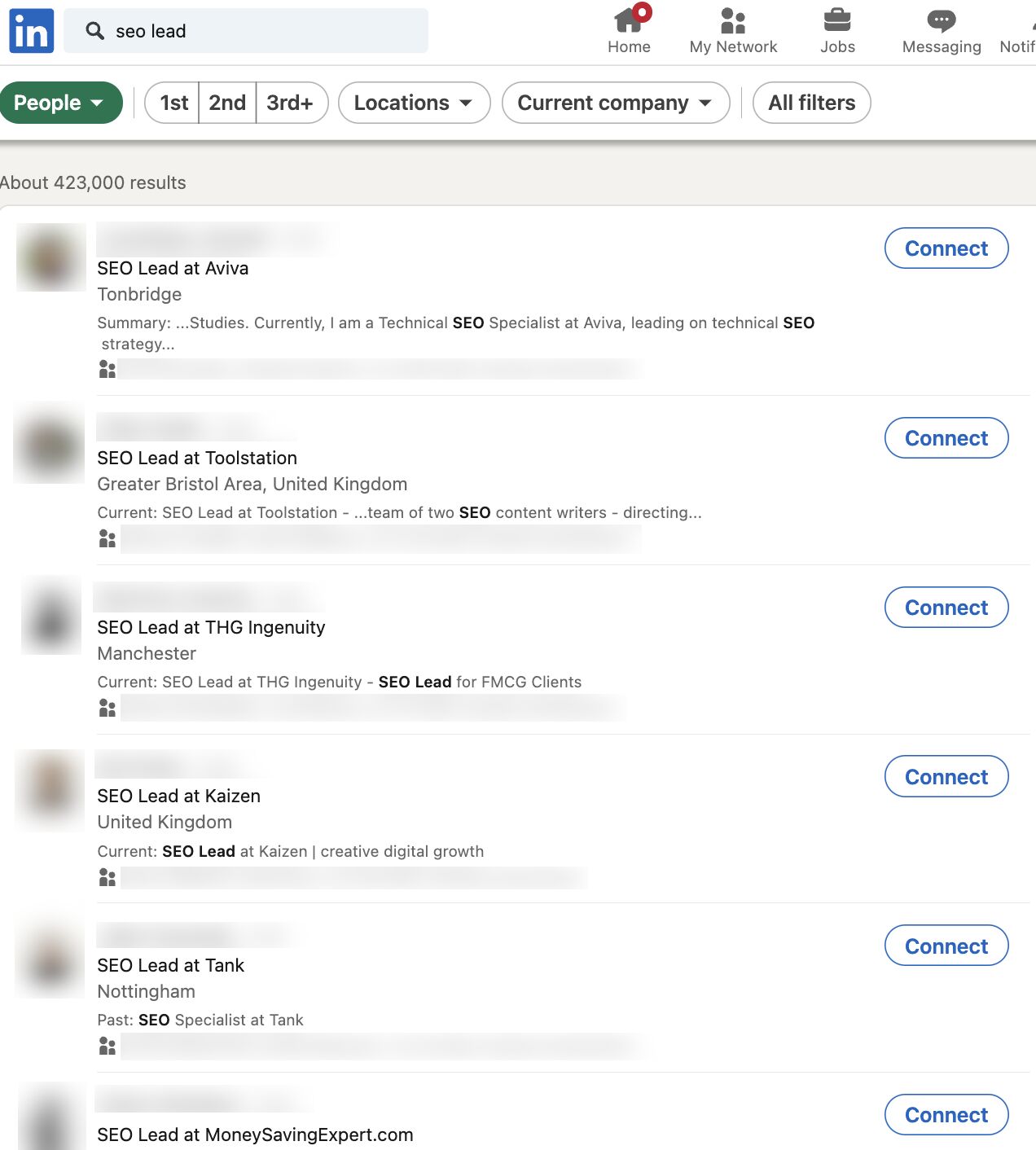
Tip
Look for common career patterns of the SEOs you admire in the industry.
I used this method to understand how my favorite SEOs and people at my company navigated their way from a junior role to a senior role.
For example, when the Head of SEO at the time Kirsty Hulse, joined my team, I added her on LinkedIn and realized that if I wanted to follow in her footsteps, I’d need to start by getting the role of SEO Manager to stand any possible chance of leading SEO campaigns like she was.
The progression in my company was from SEO Executive to Senior SEO Executive (Junior roles in London, UK), but as an outsider coming into the company, Kirsty showed me that it was possible to jump straight to SEO Manager given the right circumstances.


Using Kirsty’s and other SEOs’ profiles, I decided that the next step in my career needed to be SEO Manager, and at some point, I needed to get some experience with a bigger media agency so I could work my way up to leading an SEO campaign with bigger brands.
Sadly, you can’t just rock up to a monthly meeting and start leading a big brand SEO campaign. You’ll need to prove yourself to your line manager first. So how can you do this?
Here’s what I’d suggest you do:
- Create a strong track record with smaller companies.
- Obsessively share your wins with your company, so that senior management will already know you can deliver.
- At your performance review, tell your line manager that you want to work on bigger campaigns and take on more responsibility.
If there’s no hope of working with a big brand at your current job, you might need to consider looking for a new job where there is a recognizable brand. This was what I realized I needed to do if I wanted to get more experience.
Tip
Get recruiters on LinkedIn to give you the inside scoop on which brands or agencies are hiring. Ask them if you have any skill gaps on your resume that could prevent you from getting a job with these companies.
Being critical of your skill gaps can be hard to do. I found the best way to identify them early in my career was to ask other people—specifically recruiters. They had knowledge of the industry and were usually fairly honest as to what I needed to improve.
From this, I realized I lacked experience working with other teams—like PR, social, and development teams. As a junior SEO, your mind is focused 99% on doing SEO, but when you become more senior, your integration with other teams is important to your success.
For this reason, I’d suggest that aspiring SEO Leads should have a good working knowledge of how other teams outside of SEO operate. If you take the time to do this, it will pay dividends later in your career:
- If there are other teams in your company, ask if you can do some onboarding training with them.
- Get to know other team leads within your company and learn how they work.
- Take training courses to learn the fundamentals of other disciplines that complement SEO, such as Python, SQL, or content creation.
Sometimes, employers use skill gaps to pay you less, so it’s crucial to get the skills you need early on…


Examples of other skill gaps I’ve noticed include:
Tip
If you think you have a lot of skill gaps, then you can brush up your skills with our SEO academy. Once you’ve completed that, you can fast-track your knowledge by taking a course like Tom Critchlow’s SEO MBA, or you can try to develop these skills through your job.


As a junior in any company, it can be hard to get your voice heard amongst the senior crowd. Ten years ago, I shared my wins with the team in a weekly group email in the office.
Here’s what you should be sharing:
- Praise from 3rd parties, e.g. “the client said they are impressed with the work this month.”
- Successful performance insights, e.g “following our SEO change, the client has seen X% more conversions this month.”
- Examples of the work you led, e.g. if your leadership and decision-making led to good results, then you need to share it.
At Ahrefs I keep a “wins” document. It’s just a simple spreadsheet that lists feedback on the blog posts I’ve written, the links I’ve earned and what newsletters my post was included in. It’s useful to have a document like this so you have a record of your achievements.
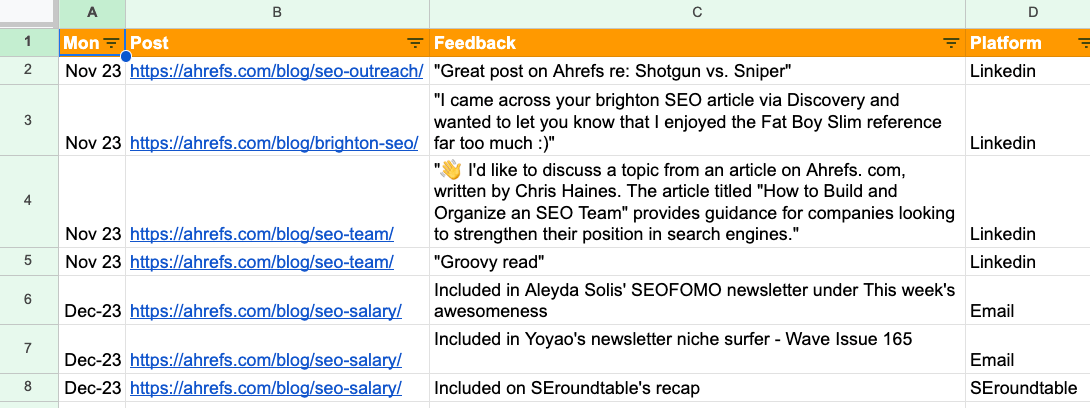

Sidenote.
Junior SEOs sometimes talk about the things “we” achieved as a team rather than what they achieved at the interview stage. If you want the SEO Lead role, remember to talk about what you achieved. While there’s no “I” in team, you also need to advocate for yourself.
One of my first big wins as an SEO was getting a link from an outreach campaign on Buzzfeed. When I went to Brighton SEO later that year and saw Matthew Howells-Barby sharing how he got a Buzzfeed link, I realized that this was not something everyone had done.
So when I did manage to become an SEO Lead, and my team won a prize in Publicis Groupe for our SEO performance, I made sure everyone knew about the work we did. I even wrote a case study on the work for Publicis Groupe’s intranet.
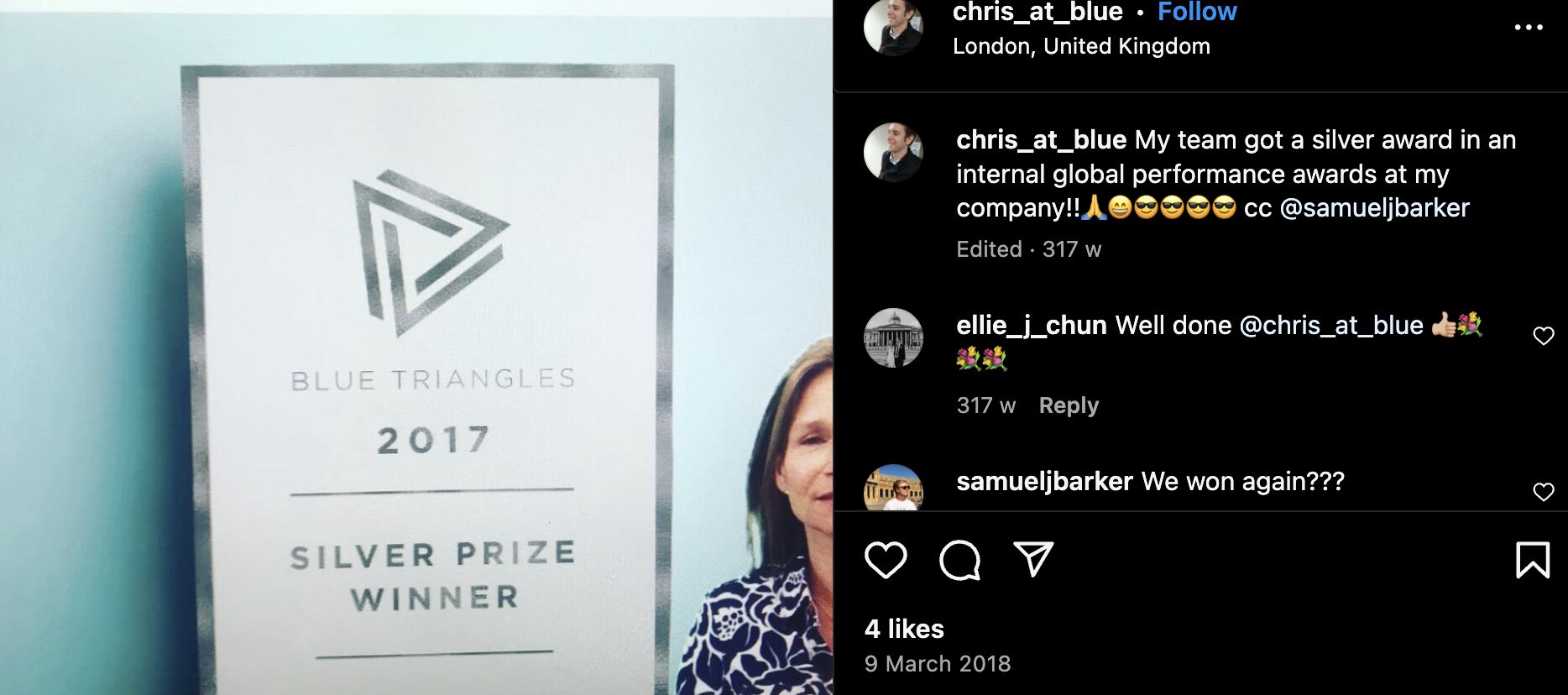

I’ve worked with some incredibly talented people, many of whom have helped me in my career.
I owe my big break to Tim Cripps, Laura Scott, and Kevin Mclaren. Without their support and encouragement, I wouldn’t be where I am today. Even before that, David Schulhof, Jodie Wheeler, and Carl Brooks let me mastermind some bonkers content campaigns that were lucky enough to succeed:


I wasn’t even an SEO Lead at that point, but they gave me the reins and trusted me.
So, how can you find your tribe?
- Speak to recruiters – they might hold the ticket to your next dream job. I spoke to many recruiters early in my career, but only two recruiters delivered for me—they were Natasha Woodford, and Amalia Gouta. Natasha helped me get a job that filled my skill gap, and Amalia helped me get my first SEO Lead role.
- Go to events and SEO conferences, and talk to speakers to build connections outside of your company.
- Use LinkedIn and other social media to interact with other companies or individuals that resonate with you.
Many senior SEO professionals spend most of their online lives on X and LinkedIn. If you’re not using them, you’re missing out on juicy opportunities.


Sharing your expertise on these platforms is one of the easiest ways to increase your chances of getting a senior SEO role. Because, believe it or not, sometimes a job offer can be just a DM away.
Here’s some specific ideas of what you can share:
- Share your thoughts on a trending topic – like the latest Google algorithm update.
- Share what you learned during the course of a campaign.
- Ask the community for their thoughts on a certain topic.
I’ve recently started posting on LinkedIn and am impressed by the reach you can get by posting infrequently on these topics.
Here’s an example of one of my posts where I asked the community for help researching an article I was writing:
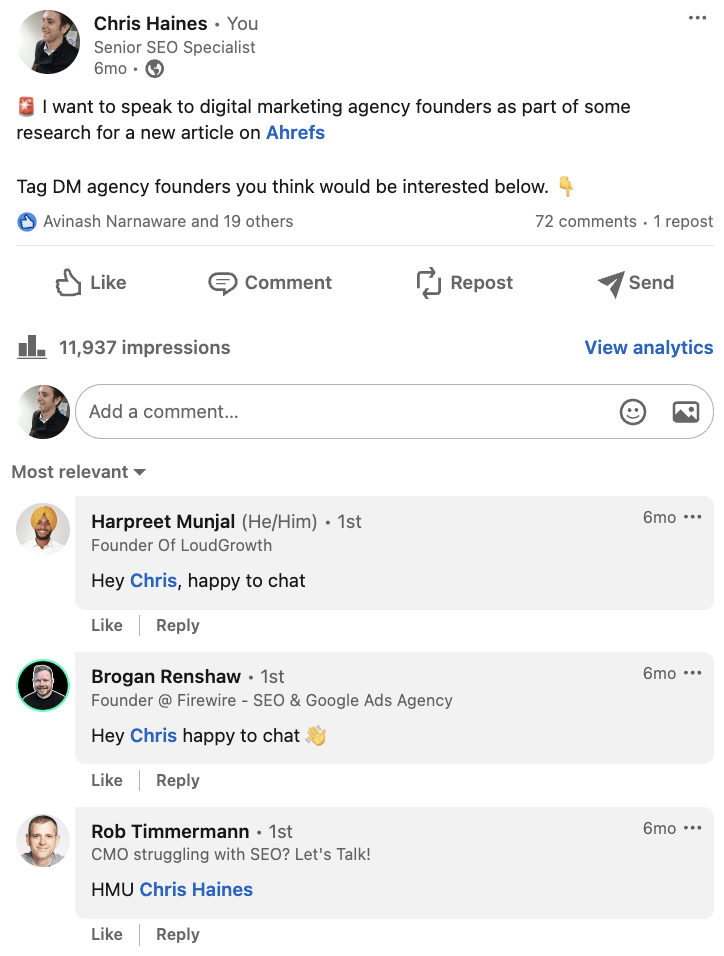

And here is the content performance across the last year from posting these updates.


I’m clearly not a LinkedIn expert—far from it! But as you can see, with just a few months of posting, you can start to make these platforms work for you.
Godard Abel, co-founder of G2, talked on a podcast about conscious leadership. This struck a chord with me recently as I realized that I had practiced some of the principles of conscious leadership—unconsciously.
You can start practicing conscious leadership by asking yourself if your actions are above or below the line. Here are a few examples of above and below-the-line thinking:
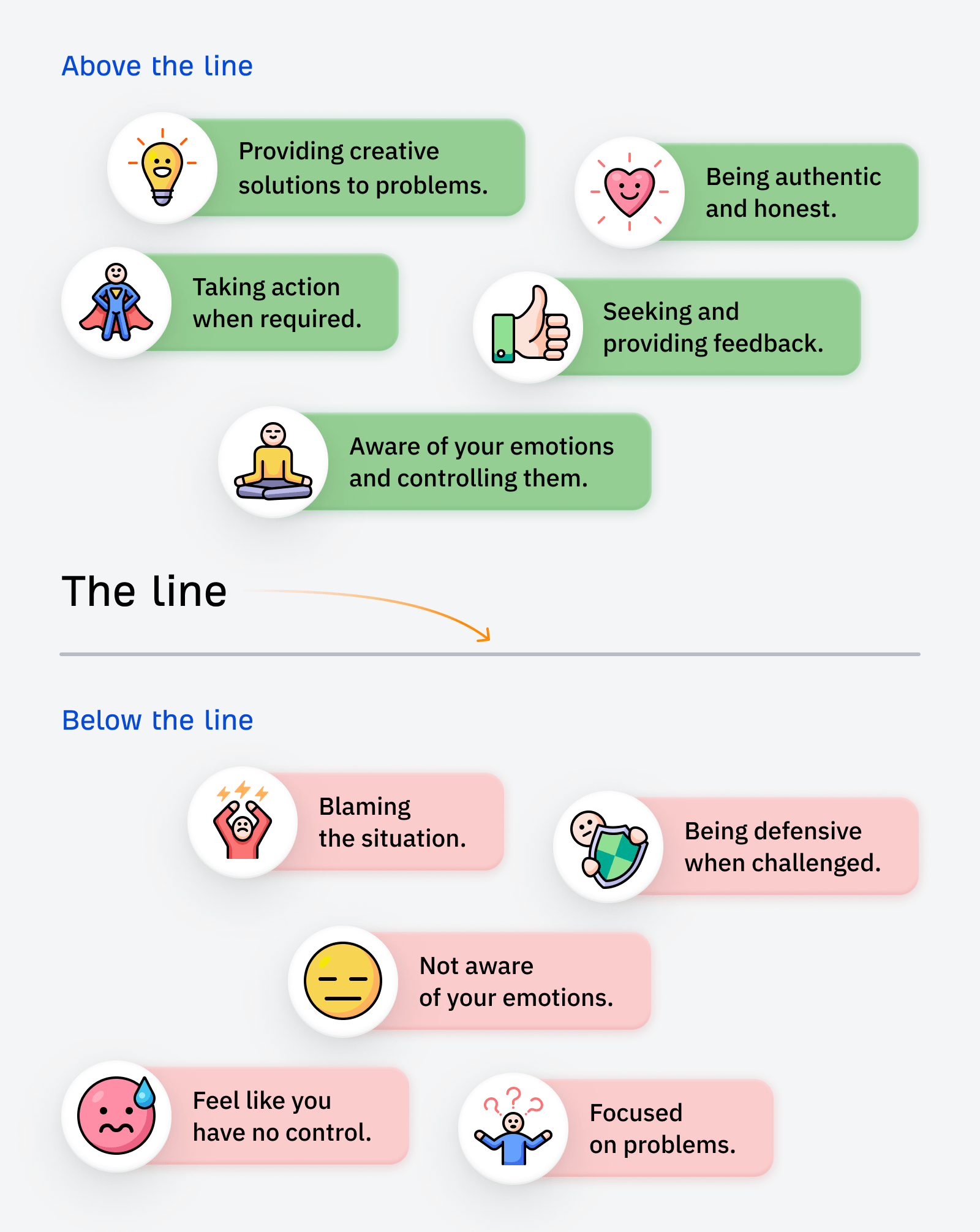

If you want a senior SEO role, I’d suggest shifting your mindset to above-the-line thinking.
In the world of SEO, it’s easy to blame all your search engine woes on Google. We’ve all been there. But a lot of the time, simple changes to your website can make a huge difference—it just takes a bit of effort to find them and make the changes.
SEO is not an exact science. Some stakeholders naturally get nervous if they sense you aren’t sure about what you’re saying. If you don’t get their support early on then you fall at the first hurdle.


To become more persuasive, try incorporating Aristotle’s three persuasive techniques into your conversations.
- Pathos: use logical reasoning, facts, and data to present water-tight arguments.
- Ethos: establish your credibility and ethics through results.
- Logos: make your reports tell a story.


Then sprinkle in language that has a high level of modality:


Some people will be able to do this naturally without even realizing it, but for others, it can be an uphill struggle. It wasn’t easy for me, and I had to learn to adapt the way I talked to stakeholders early on.
The strongest way I found was to appeal to emotions and back up with data from a platform like Ahrefs. Highlight what competitors have done in terms of SEO and the results they’ve earned from doing it.
Sidenote.
You don’t have to follow this tip to the letter, but being aware of these concepts means you’ll start to present more confident and persuasive arguments for justifying your SEO strategies.
When I started in SEO, I had zero connections. Getting a job felt like an impossible challenge.
Once I’d got my first SEO Lead job, it felt stupidly easy to get another one—just through connections I’d made along the way in my SEO journey.
I once got stuck on a delayed train with a senior member of staff, and he told me he was really into Google Local Guides, and he was on a certain high level. He said it took him a few years to get there.
Local Guides is part of Google Maps that allows you submit reviews and other user generated content
When he showed me the app, I realized that you could easily game the levels by uploading lots of photos.
In a “hold my beer” moment, I mass downloaded a bunch of photos, uploaded them to Local Guides and equaled his Local Guide level on the train in about half an hour. He was seething.


One of the photos I uploaded was a half-eaten Subway. It still amazes me that 50,974 people have seen this photo:
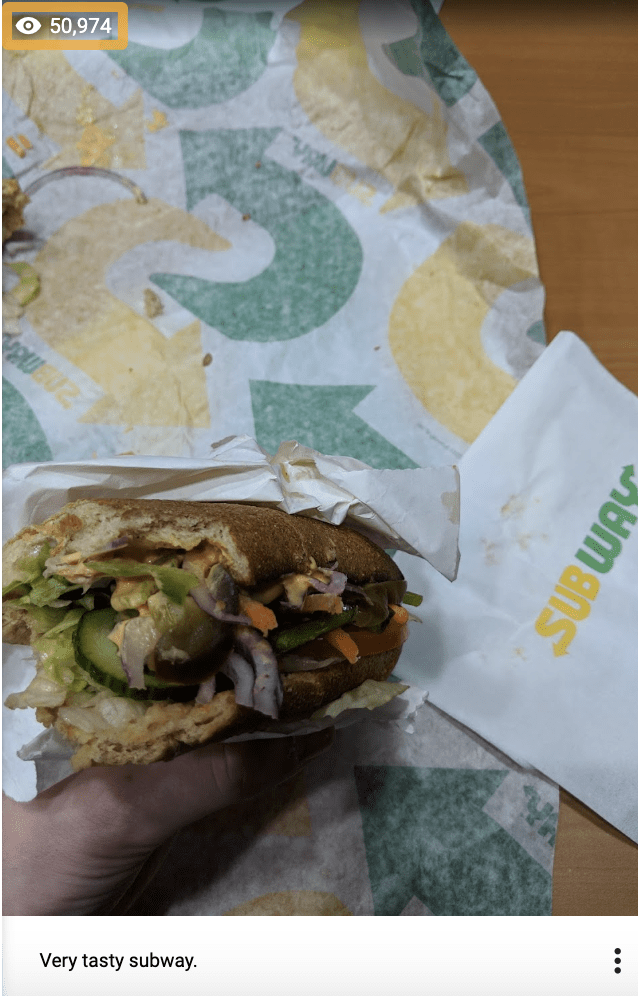

This wasn’t exactly SEO, but the ability to find this ‘hack’ so quickly impressed him, and we struck up a friendship.
The next month that person moved to another company, and then another few months later, he offered me an SEO Lead job.
Tip
Build connections with everyone you can—you never know who you might need to call on next.
Final thoughts
The road to becoming an SEO Lead seems straightforward enough when you start out, but it can quickly become long and winding.
But now armed with my tips, and a bucket load of determination, you should be able to navigate your way to an SEO Lead role much quicker than you think.
Lastly, if you want any more guidance, you can always ping me on LinkedIn. 🙂
SEO
7 Content Marketing Conferences to Attend in 2024
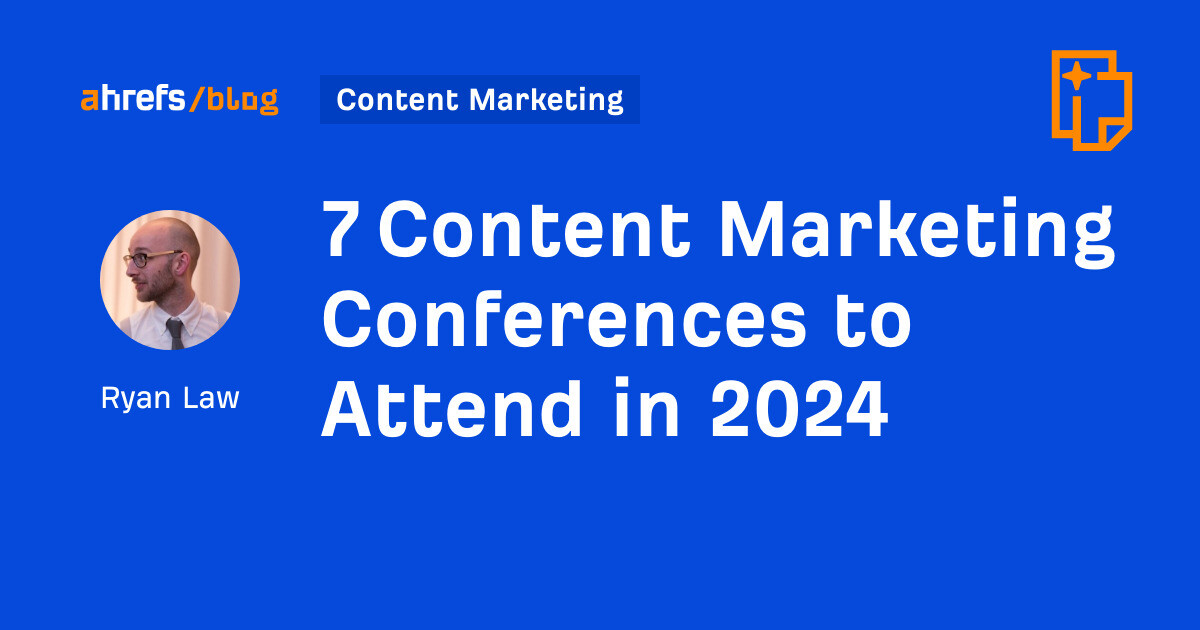
I spend most of my days sitting in front of a screen, buried in a Google Doc. (You probably do too.)
And while I enjoy deep work, a few times a year I get the urge to leave my desk and go socialize with other human beings—ideally on my employer’s dime 😉
Conferences are a great excuse to hang out with other content marketers, talk shop, learn some new tricks, and pretend that we’re all really excited about generative AI.
Without further ado, here are the biggest and best content marketing conferences happening throughout the rest of 2024.
Dates: May 5–7
Prices: from $795
Website: https://cex.events/
Location: Cleveland, OH
Speakers: B.J. Novak, Ann Handley, Alexis Grant, Justin Welsh, Mike King
CEX is designed with content entrepreneurs in mind (“contenpreneurs”? Did I just coin an awesome new word?)—people that care as much about the business of content as they do the craft.
In addition to veteran content marketers like Ann Handley and Joe Pulizi waxing lyrical about modern content strategy, you’ll find people like Justin Welsh and Alexis Grant exploring the practicalities of quitting your job and becoming a full-time content creator.
Here’s a trailer for last year’s event:
Sessions include titles like:
- Unlocking the Power of Book Publishing: From Content to Revenue
- Quitting A $200k Corporate Job to Become A Solo Content Entrepreneur
- Why You Should Prioritize Long-Form Content
(And yes—Ryan from The Office is giving the keynote.)
Dates: Jun 3–4
Location: Seattle, WA
Speakers: Wil Reyolds, Bernard Huang, Britney Muller, Lily Ray
Prices: from $1,699
Website: https://moz.com/mozcon
Software company Moz is best known in the SEO industry, but its conference is popular with marketers of all stripes. Amidst a lineup of 25 speakers there are plenty of content marketers speaking, like Andy Crestodina, Ross Simmonds, and Chima Mmeje.
Check out this teaser from last year’s event:
This year’s talks include topics like:
- Trust and Quality in the New Era of Content Discovery
- The Power of Emotion: How To Create Content That (Actually) Converts
- “E” for Engaging: Why The Future of SEO Content Needs To Be Engaging
Dates: Sep 18–20
Location: Boston, MA
Speakers: TBC
Prices: from $1,199
Website: https://www.inbound.com/
Hosted by content marketing OG HubSpot, INBOUND offers hundreds of talks, deep dives, fireside chats, and meetups on topics ranging from brand strategy to AI.
Here’s the recap video:
I’ve attended my fair share of INBOUNDs over the years (and even had a beer with co-founder Dharmesh Shah), and always enjoy the sheer choice of events on offer.
Keynotes are a highlight, and this year’s headline speaker has a tough act to follow: Barack Obama closed out the conference last year.
Dates: Oct 22–23
Location: San Diego, CA
Speakers: TBC
Prices: from $1,199
Website: https://www.contentmarketingworld.com/
Arguably the content marketing conference, Content Marketing World has been pumping out content talks and inspiration for fourteen years solid.
Here’s last year’s recap:
The 2024 agenda is in the works, but last year’s conference explored every conceivable aspect of content marketing, from B2C brand building through to the quirks of content for government organizations, with session titles like:
- Government Masterclass: A Content Marketing Strategy to Build Public Trust
- A Beloved Brand: Evolving Zillow’s Creative Content Strategy
- Evidence-Based SEO Strategies: Busting “SEO Best Practices” and Other Marketing Myths
Dates: Oct 24–25
Location: Singapore
Speakers: Andy Chadwick, Nik Ranger, Charlotte Ang, Marcus Ho, Victor Karpenko, Amanda King, James Norquay, Sam Oh, Patrick Stox, Tim Soulo (and me!)
Prices: TBC
Website: https://ahrefs.com/events/evolve2024-singapore
That’s right—Ahrefs is hosting a conference! Join 500 digital marketers for a 2-day gathering in Singapore.
We have 20 top speakers from around the world, expert-led workshops on everything from technical SEO to content strategy, and tons of opportunities to rub shoulders with content pros, big brands, and the entire Ahrefs crew.
I visited Singapore for the first time last year and it is really worth the trip—I recommend visiting the Supertree Grove, eating at the hawker markets in Chinatown, and hitting the beach at Sentosa.
If you need persuading, here’s SEO pro JH Scherck on the Ahrefs podcast making the case for conference travel:
And to top things off, here’s a quick walkthrough of the conference venue:
Dates: Oct 27–30
Location: Portland, OR
Speakers: Relly Annett-Baker, Fawn Damitio, Scott Abel, Jennifer Lee
Prices: from $1,850
Website: https://lavacon.org/
LavaCon is a content conference with a very technical focus, with over 70 sessions dedicated to helping companies solve “content-related business problems, increase revenue, and decrease production costs”.
In practice, that means speakers from NIKE, Google, Meta, Cisco, and Verizon, and topics like:
- Operationalizing Generative AI,
- Taxonomies in the Age of AI: Are they still Relevant?, and
- Out of Many, One: Building a Semantic Layer to Tear Down Silos
Here’s the recap video for last year’s conference:
Dates: Nov 8
Location: London
Speakers: Nick Parker, Tasmin Lofthouse, Dan Nelken, Taja Myer
Prices: from £454.80
Website: https://www.copywritingconference.com/
CopyCon is a single-day conference in London, hosted by ProCopywriters (a membership community for copywriters—I was a member once, many years ago).
Intended for copywriters, creatives, and content strategists, the agenda focuses heavily on the qualitative aspects of content that often go overlooked—creative processes, tone of voice, and creating emotional connections through copy.
It’s a few years old, but this teaser video shares a sense of the topics on offer:
This year’s talks include sessions like:
- The Mind-Blowing Magic of Tone of Voice,
- The Power of AI Tools as a Content Designer, and the beautifully titled
- Your Inner Critic is a Ding-Dong.
(Because yes, your inner critic really is a ding-dong.)
Final thoughts
These are all content-specific conferences, but there are a ton of content-adjacent events happening throughout the year. Honourable mentions go to DigiMarCon UK 2024 (Aug 29–30, London, UK), Web Summit (Nov 11–14, Lisbon, Portugal), and B2B Forum (Nov 12–14, Boston, MA).
I’ve focused this list solely on in-person events, but there are also online-only conferences available, like ContentTECH Summit (May 15–16).
Heading to a content conference that I haven’t covered? Share your recommendation with me on LinkedIn or X.
-

 PPC4 days ago
PPC4 days ago19 Best SEO Tools in 2024 (For Every Use Case)
-

 PPC7 days ago
PPC7 days ago4 New Google Ads Performance Max Updates: What You Need to Know
-

 MARKETING7 days ago
MARKETING7 days agoWill Google Buy HubSpot? | Content Marketing Institute
-
SEARCHENGINES6 days ago
Daily Search Forum Recap: April 16, 2024
-

 SEO6 days ago
SEO6 days agoGoogle Clarifies Vacation Rental Structured Data
-

 MARKETING6 days ago
MARKETING6 days agoStreamlining Processes for Increased Efficiency and Results
-
SEARCHENGINES5 days ago
Daily Search Forum Recap: April 17, 2024
-

 PPC7 days ago
PPC7 days agoHow to Collect & Use Customer Data the Right (& Ethical) Way
















You must be logged in to post a comment Login